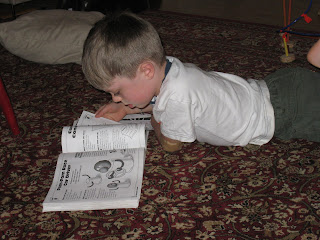Teaching the Bible was a real challenge for this agnostic homeschooler. I knew the overall approach I wanted to take: This is one of the most influential books in world history, I told the kids. Millions of people believe it contains the words of their God, and that every word in it is true; millions more have been affected by its teachings; its stories and themes will show up over and over again in the things you read and see in your life. And as you grow up, you'll make your own decisions about whether to view it as a great work of literature or a divinely-inspired text.
But there is so much religiously oriented material out there, it was difficult for me to know how to wade through it and find some books or other resources that seemed right. I came up with a few things, but this unit ended up being pretty brief for us (though not as brief or disastrous as our New Testament unit, about which I will write later).
Reading
Obviously, The Book was the main book. There are lots of Bibles for kids out there; we mainly used
The Usborne Children's Bible
and
The DK Children's Illustrated Bible
, both of which come in cute small editions. We focused on the stories of creation, Adam and Eve, Noah and the Flood, Joseph, and Moses.
Good picture books are available for many of the Old Testament tales. We especially liked Arthur Geisert's marvelously and whimsically illustrated
The Ark
.

In detailed black and white etchings, Geisert portrays how the Ark itself might have been constructed and imagines the nitty gritty of life during those fabled 40 days and 40 nights, including the important matter of excrement disposal. We spent hours pouring over these illustrations, giggling as we tracked the damage to the ship's timbers by voracious beavers. The story of the Flood can be traumatic to sensitive children -- after all, God massacres virtually every living thing on earth -- but this book helped my kids focus on the survivors. (Nini noted, in any case, that the creatures of the sea were necessarily spared from God's punishment.)
 An even bigger favorite in our household was The Moses Basket
An even bigger favorite in our household was The Moses Basket , by Jenny Koralek and Pauline Baynes. It sweetly captures the dramatic tale of Moses' infancy, with illustrations that vividly portray the day-to-day world of Ancient Egypt. Our drively quickly became the Nile, and Nini's baby doll must have floated down it a hundred times.
, by Jenny Koralek and Pauline Baynes. It sweetly captures the dramatic tale of Moses' infancy, with illustrations that vividly portray the day-to-day world of Ancient Egypt. Our drively quickly became the Nile, and Nini's baby doll must have floated down it a hundred times.
The illustrations in Brian Wildsmith's well-crafted Joseph and Exodus
and Exodus also provided welcome continuity with our study of Ancient Egypt.
also provided welcome continuity with our study of Ancient Egypt.
FilmYep, we did it: We were crazy enough to watch the entire
Ten Commandments
(in three installments, mind you). It was great campy fun for me, and they -- like the movie audiences of 50 years ago -- were dazzled by the dated special effects.
But that was it for us. Surely there are other things we missed -- please post any other recommendations.
PlayWe fashioned our own Noah's Ark and populated it with little plastic animals we already had lying about; there are, of course, a great many custom-made Ark playsets out there, some of them quite lovely. But beyond that, and the Moses basket play mentioned above, the Old Testament just didn't make its way into my kids' play life the way Egypt or even Mesopotamia had. Ideas or suggestions, dear readers?
 Our homeschool study of Ancient India was a revelation and a delight for all of us. I knew relatively little about the material and enjoyed my first encounter with The Ramayana and the legends of Ganesh every bit as much as my kids. Well, maybe not as much as much animal-loving daughter, who fell hard for the elephant-headed god and the magical monkey Hanuman, among many other figures from Hindu mythology. (That's her recreating the monkey bridge to Lanka; plesiosaurs, however, do not figure into the original tale.)
Our homeschool study of Ancient India was a revelation and a delight for all of us. I knew relatively little about the material and enjoyed my first encounter with The Ramayana and the legends of Ganesh every bit as much as my kids. Well, maybe not as much as much animal-loving daughter, who fell hard for the elephant-headed god and the magical monkey Hanuman, among many other figures from Hindu mythology. (That's her recreating the monkey bridge to Lanka; plesiosaurs, however, do not figure into the original tale.) Ganesh, the steadfast child of Shiva and Parvati who was fated swap his human head for one of an elephant, is widely beloved by children, and stories of his life are a great way to begin your study of Hindu mythology. Elephant Prince: The Story of Ganesh, is a stunningly beautiful introduction and highly recommended. Belgin K. Wedman's illustrations are breath-taking, and Amy Novesky tells the tale charmingly. Uma Krishnaswami's The Broken Tusk: Stories of the Hindu God Ganesha has simple line drawings for illustrations, but it covers so many episodes from the elephant-headed god's life that it too is highly recommended for any child who becomes captivated by this Hindu deity. How Ganesh Got His Elephant Head by Hanish Johari and Vatsala Sperling, part of a series of classic Indian stories for children (discussed further below), is another fine choice.
Ganesh, the steadfast child of Shiva and Parvati who was fated swap his human head for one of an elephant, is widely beloved by children, and stories of his life are a great way to begin your study of Hindu mythology. Elephant Prince: The Story of Ganesh, is a stunningly beautiful introduction and highly recommended. Belgin K. Wedman's illustrations are breath-taking, and Amy Novesky tells the tale charmingly. Uma Krishnaswami's The Broken Tusk: Stories of the Hindu God Ganesha has simple line drawings for illustrations, but it covers so many episodes from the elephant-headed god's life that it too is highly recommended for any child who becomes captivated by this Hindu deity. How Ganesh Got His Elephant Head by Hanish Johari and Vatsala Sperling, part of a series of classic Indian stories for children (discussed further below), is another fine choice.  A great series published by Vermont's Bear Cub Books will enable you to explore individual Hindu deities in greater depth. Titles include The Magical Adventures of Krishna: How a Mischief Maker Saved the World, How Parvati Won the Heart of Shiva, and Ganga: The River That Flows from Heaven to Earth.
A great series published by Vermont's Bear Cub Books will enable you to explore individual Hindu deities in greater depth. Titles include The Magical Adventures of Krishna: How a Mischief Maker Saved the World, How Parvati Won the Heart of Shiva, and Ganga: The River That Flows from Heaven to Earth. While you're studying the Ramayana, you'll want to see Nini Paley's extraordinary animated film, Sita Sings the Blues, an inspired feminist interweaving of the tale of the Hindu epic with episodes from Paley's own life. I can't recommend it strongly enough, but do advise that there is some cartoony violence in the film and a curse word or two, which will likely sail over your young children's heads.
While you're studying the Ramayana, you'll want to see Nini Paley's extraordinary animated film, Sita Sings the Blues, an inspired feminist interweaving of the tale of the Hindu epic with episodes from Paley's own life. I can't recommend it strongly enough, but do advise that there is some cartoony violence in the film and a curse word or two, which will likely sail over your young children's heads.





















